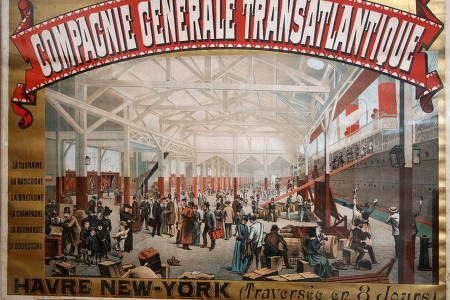Migrations interview: Part three

The voyage overseas could only begin once families had given their consent to the emigranti and the necessary funds had been scraped together. In this section, Cheda describes the journey.
swissinfo: Let’s take a step back and talk about how they actually travelled abroad. Did the first emigranti in the 1850s begin their journey on foot, or did they take diligences (stagecoaches) to the ports?
Giorgio Cheda: They travelled partly on foot, partly by diligence and partly by train. There were already sections of railway – because in the 1850s they were beginning to build railways very quickly – in both France and Germany. So it was possible to get to the ports of embarkation using fairly good means of transport.
Some parts of the journey did have to be covered on foot, for example the St. Gotthard. They could go as far as Airolo with the diligence, but then they had to cross the pass on foot.
I’m thinking of a letter from someone writing from Hamburg to say they had had to leave one of their companions in a hospital somewhere because, climbing hurriedly over the Gotthard pass in cold weather and snow, he had caught pneumonia.
So this chap had to be taken to hospital, stay there until he was better, then join the following convoy so he could reach Hamburg and take the next ship, which was leaving the following month, and so arrive in Melbourne later than the group with which he had begun the journey. But generally the journey to the port of embarkation was fairly easy, because it could be done by public transport.
swissinfo: Was Hamburg the only port they embarked from?
Giorgio Cheda: Almost all of the 2,000 emigrating to Australia took the ship from Hamburg, for the reason I explained before: the Hamburg recruitment agencies exerted pressure so they could fill their ships with passengers for Australia. Some went to London, some to Dieppe or other northern European ports but almost all left from Hamburg.
But for California the assembly point was Le Havre. In 1850, 1880, 1890, almost all emigrants bound for California embarked at Le Havre for New York.
For Australia, the voyage was by sailing ship. Of course, sailing ships were dependent on the winds and might take up to six months, as I have been able to discover by comparing the dates of embarkation in Hamburg, where I have been to research the ships’ passenger lists, with the disembarkation lists in Melbourne.
Meanwhile, the journey to California was fairly long until 1869, because they had to go round South America, round Cape Horn, then sail up the Pacific coast. After 1869, when the construction of the first transcontinental railroad was completed, the train journey from New York to San Francisco took no more than ten days, maybe only a week. So getting to California in 1870 or 1880 was relatively easy. It took about a month: three weeks to cross the Atlantic and then, from New York to San Francisco, a further week by train – and there you were.
This explains why return journeys to California in the late 19th/early 20th century were, I would say, fairly common, especially for those families who, having a ranch in California but still having relatives and friends in the villages here, wanted to return fairly often to visit their places of origin. So many very positive contacts were maintained between the valleys of Ticino and the “colonies” the Ticinesi had founded in California.
Cont.
Ticino population:
1850: approx. 118,000
1900: 139,000
1950: 175,000
2000: 307,000
Today: 330,000
(Official canton Ticino statistics)

In compliance with the JTI standards
More: SWI swissinfo.ch certified by the Journalism Trust Initiative












You can find an overview of ongoing debates with our journalists here . Please join us!
If you want to start a conversation about a topic raised in this article or want to report factual errors, email us at english@swissinfo.ch.